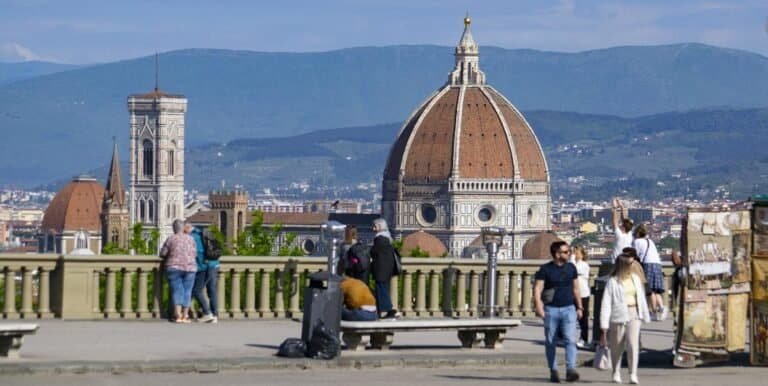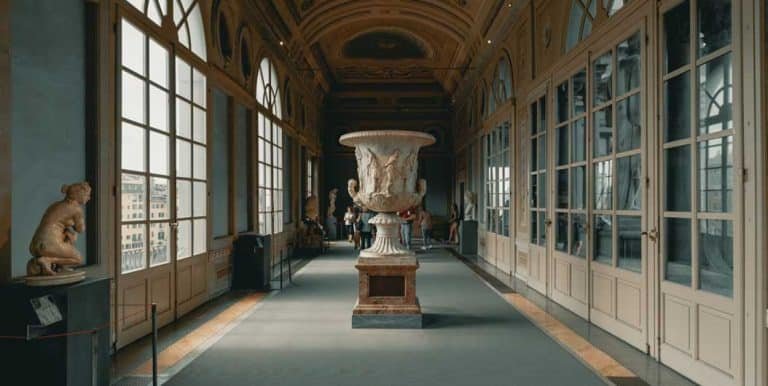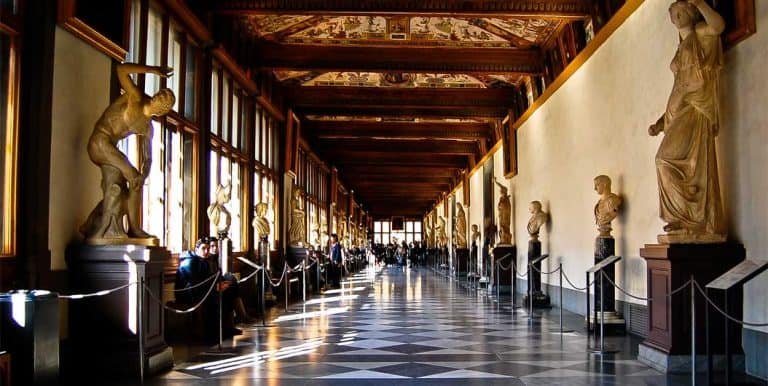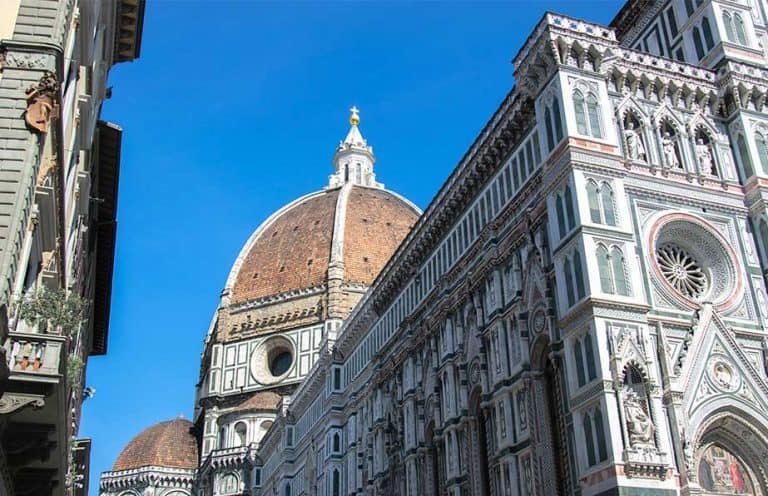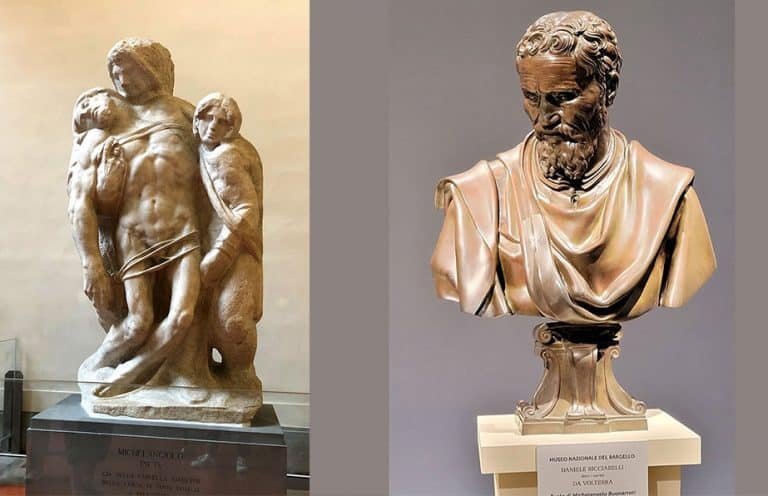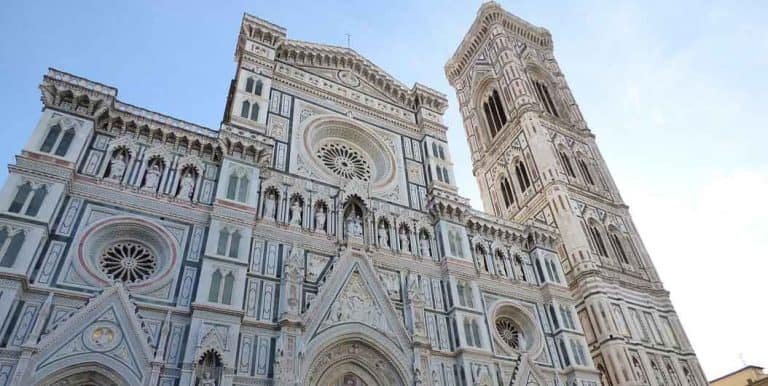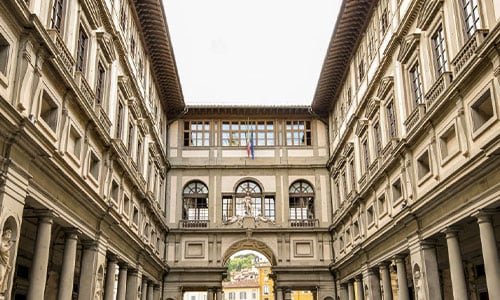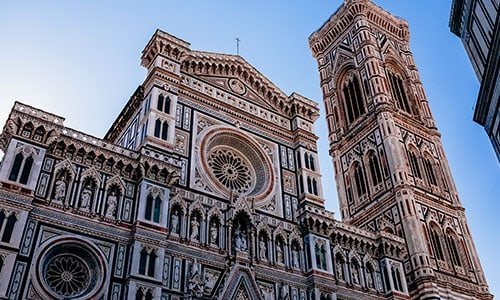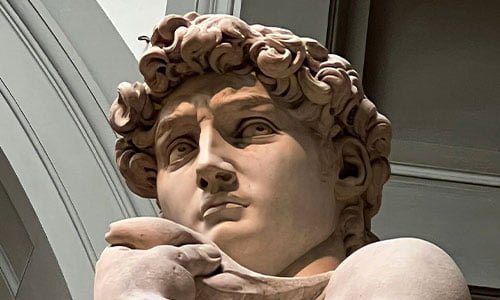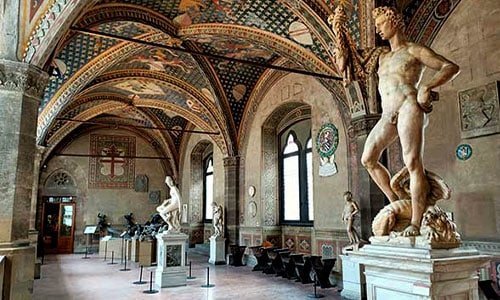The florence baptistery
Florence Baptistery is one of the architectural wonders of Florence, along with the Duomo and Giotto’s Campanile, is the Baptistry of San Giovanni. Explore its history and the masters who created its spectacular artistic treasures.
History of the Florence Baptistery – Baptistry of San Giovanni in Florence
The Florence Baptistery of San Giovanni is one of the oldest churches in Florence. The first religious structure built in this location dates back to the 4th or 5th century AD. Initially, it stood outside the city walls and only became part of the city with the construction of the fourth city wall.
San Giovanni Battista became the patron saint of Florence in the 6th century, during the Lombard rule under Queen Teodolinda. She chose him to protect her people and the cities she governed.
During Roman times, in the 1st century AD, there was a Roman domus or even a temple dedicated to the god Mars, as evidenced by the archaeological remains found.
Over the centuries, the structure underwent gradual modifications and was used to inaugurate knights, oaths and celebrate the feast of San Giovanni.
In 1059, with the consecration by Pope Nicholas II, it officially became a church, and when the Duomo was built in 1128, it was transformed into a baptistery.

The architecture of the Baptistry of Florence
The original baptistery was elevated. To enter, one had to climb a few steps, which disappeared when the street level was raised.
The building has an octagonal plan, a shape that symbolizes the eighth day in the past, representing resurrection and eternity. It is worth noting that it was initially located near a cemetery. The style and materials used recall those of the nearby Church of Santa Maria del Fiore, also known as the Duomo.
Its façades are divided into three architectural levels. The lower part features doors, pilasters, and panels, while the middle section showcases arches and windows of various shapes topped with tympanums. The top section consists of an attic. Resting on it is the dome with a flattened pyramid shape, divided into eight sections, and in the center is the lantern.
The florence baptistery doors

Beautiful bronze doors open on three sides of the baptistery, subsidized by the guilds of wealthy Florentine merchants. The ones on display are recent replicas, as the original doors are preserved in the Museum of the Opera.
During World War II, the doors were dismantled and transferred to a railway gallery to protect them from bombings.
The flood of 1966, however, caused significant damage. As a result, a definitive decision was made to safeguard them in the Museum of the Opera. After careful restoration, they have regained their splendor and are admired by thousands of visitors.
The work to create the three original doors lasted over a century due to their meticulous decorations. They were meant to illustrate biblical episodes and the redemption of humanity.
SOUTH DOOR BY ANDREA PISANO
The South Door, weighing eight tons, was created by Andrea Pisano between 1330 and 1336. It consists of 28 quatrefoil panels arranged in seven rows. The panels depict scenes from the life of Saint John the Baptist, the patron saint of Florence, and the Christian virtues of Faith, Hope, Charity, Humility, Prudence, Justice, Fortitude, and Temperance.
The gilding was done using a mixture of bronze and gold, while around the panels are rosettes, lion heads, and pyramid shapes.
The frame of the South Door is also rich in symbolism. It was divided into two parts. One side features the figure of Adam, with plants representing fertility, such as wheat sheaves, lilies, and olive branches. On the other side is Eve with harmful and poisonous plants like poppies, holly, viburnum, and sorghum, symbolizing misfortune and recalling the original sin.
The bronze sculpture of the Beheading of Saint John the Baptist, which used to crown the door, is now displayed in the Museum of the Opera.
NORTH DOOR BY LORENZO GHIBERTI
On the other hand, the North Door was created by Lorenzo Ghiberti, who worked on it from 1402 to 1424. As a student of Leonardo da Vinci, he was chosen after winning a specific competition in which Brunelleschi also participated.
The 28 panels of the North Door are quatrefoil and narrate stories from the Old Testament, representing the evangelists.
Among the decorative elements on the frame, one can notice small heads of prophets and sibyls and vegetal and animal motifs. One of the tiny heads in the central part represents Ghiberti‘s self-portrait.
In the past, a sculpture of the Preaching of the Baptist adorned the upper part, but now a bronze replica is exhibited in the Museum of the Opera.
EAST DOOR OR GATE OF PARADISE

The last door is the one facing the cathedral and is also the most important. It was created by Lorenzo Ghiberti, assisted by other artists such as Luca della Robbia and Donatello. The work, in this case, lasted from 1425 to 1452.
The Gate of Paradise displays ten square and gilded panels depicting over 50 scenes from the Old Testament.
The rich decoration of the frame also includes 24 heads of prophets and sibyls, two of which are the self-portraits of Lorenzo Ghiberti and his son Vittore.
It is called the “Gate of Paradise.” One of them comes from the exclamation made by Michelangelo when he saw it. Such was its beauty that he said it looked like the “gate of Paradise” itself.
According to another interpretation, the name was given because it faced a cemetery between the church and the baptistry.
The sculpture initially placed above the door depicted the Three Theological Virtues of Charity, Faith, and Hope, of which only fragments remain. It was later replaced by the Baptism of Christ by Andrea Sansovino. Again, a copy is found above the portal, while the original is in the museum.
The Gate of Paradise has inspired many artists. For example, Auguste Rodin created the bronze Gate of Hell, now exhibited at the Musée Rodin in Paris.
RED PORPHYRY COLUMNS
Looking at the front facade of the baptistery, on either side of the Gate of Paradise, you can also see two broken red porphyry columns. They were damaged during the flood of 1424.
The story of the two pillars is quite exciting and begins in 1117. At that time, they were “donated” by the Pisans to the Florentines as a sign of gratitude for their help.
As a maritime republic, Pisa was engaged in a war against the Muslims in the Balearic Islands, so they asked Florence to watch over their territories.
When the Pisans returned with their war booty, they also brought these two red porphyry columns, believed to possess a “magical power“…
According to legend, it was possible to recognize traitors and wrongdoers by looking at their reflections. This enticed the Florentines to desire them as a reward for their assistance.
Despite the momentary aid, there had never been good blood between the two Tuscan cities, so the Pisans, out of spite, broke the columns and then delivered them to the Florentines. Who could no longer use them to expose criminals?
baptistery florence opening hours
Monday to Friday: 8:15 am until 10:15 am and from 11:15 am until 7:30 pm
Saturday: de 8:15 am until 6:30 pm
Sunday and the first Saturday of every month: 8:15 am – 1:30 pm
Duomo Florence Opening Hours
- Florence Cathedral: Monday to Saturday between 10:15 AM to 4:45 PM. Closed on Sundays.
- Dome: Monday to Friday between 8:15 AM to 7:30 PM. On Saturday between 8:15 AM and 5:15 PM and on Sunday, between 12:24 PM and 5:15 PM.
- Giotto’s Bell Tower: Daily, from 8:15 AM to 7:45 PM.
- Duomo Museum: Open from 9 AM to 7:45 PM. Closed on the first Tuesday of every month.
You can fine more details about Duomo Florence from this link:
Duomo Florence Mass Timings
- Monday to Saturday: 8 AM, 8:30 AM, 10 AM, 5: 30 PM, and 6 PM
- Sundays and Holidays: 9 AM, 10 AM, 10:30 AM, 5:15 PM and 6 PM.
INTERIOR OF THE BAPTISTRY OF FLORENCE

When entering the baptistry, one is completely mesmerized by the beauty and grandeur of the place. It starts with the flooring, which is covered in infinite inlaid marble patterns. Its appearance resembles an ancient Roman temple, and it is no coincidence that most of the materials come from the ruins of the ancient Roman city of Florentia.
Like the exterior of the florence baptistery, the interior is divided into three architectural levels, entirely decorated with colored marble and mosaics with a golden background. The loggias or matron stand out in the central part, composed of three groups of two-light windows on each side.
The splendid vault, adorned with very ancient mosaics, some dating back to 1270, depicts Christ the Judge surrounded by prophets and patriarchs, as well as scenes from the Last Judgment and hierarchies of angels.
WHAT TO SEE IN THE BAPTISTRY OF FLORENCE
Thanks to its long history, there are many exciting things to see inside the Florence Baptistery.
ZODIAC PAVEMENT
Among the various floor decorations is a beautiful marble zodiac dating back to the 13th century. The twelve zodiac signs are arranged in a circle around the sun, and an inscription recalls the importance of the celestial body considered the universe‘s engine.
Its current position is different from when it was built, as the arrangement of the floor decorations has changed over time. Before the lantern was constructed, the dome, every 21 June, the sun entered through an opening in the roof and hit the sign of Cancer, thus establishing the summer solstice.
virtual tour of baptistry of florence
BAPTISMAL FONTS
The original baptismal font was located in the center of the baptistry, where the octagonal terracotta pavement is now visible. According to the chronicles, it was also used for the baptism of Dante Alighieri, which took place on Holy Saturday in 1266.
Currently, in one corner of the florence baptistery, you can see the baptismal font created by a student of Andrea Pisano in 1371. However, in 1576, Bernardo Buontalenti designed another font specifically for the baptism of Prince Filippo de’ Medici, the son of Grand Duke Francesco I and Joanna of Austria. The original remains are preserved at the Opera Museum.
What is the dress code for baptistery Florence?
Access to the florence baptistery is only possible in appropriate clothing. This means covered knees and no bare shoulders, sandals, headgear, or sunglasses.
MAIN ALTAR
In front of the Gate of Paradise, the main altar is carved in a rectangular “niche,” a raised platform created by Leonardo da Vinci. The vault preceding it is decorated with the oldest mosaics in the florence baptistery.
The current altar, built at the beginning of the 20th century, has a Neo-Romanesque appearance and is the most modern part of the florence baptistery.
The nearby column on a lion displays an angel holding a candle. At the same time, the archaeological excavations of the Roman domus can be seen through the grille in front of the altar.
The Museum of the Opera has a precious altar made of silver, enamel, and fine wood, created by multiple artists in 1367 and commissioned by the Florentine merchants’ corporation.
It was a movable altar that, on certain occasions, was placed in the centre and used to display treasures, liturgical objects, and shrines.
TOMB OF ANTIPAPA GIOVANNI XXIII
On one wall, you can also see the tomb of Baldassare Cossa, who became an antipope under the name John XXIII and was a friend of the Medici family. Donatello created the funerary monument in marble and bronze.
The Patriarch of Constantinople donated the index finger of St. John the Baptist, which is now located in the Museum of the Opera, to Giovanni XXIII. Other relics are also preserved in the shrine of the octagonal hall of the museum.
In the baptistery until the flood of 1966, there was also the touching wooden statue of the penitent Magdalene, made in 1450 by Donatello. Today, it is also preserved in a display case in the Museum of the Opera.
The Column of Saint Zanobi (Colonna di San Zanobi)

In Piazza di San Giovanni, in front of the North Gate of the florence baptistery, you can see the column of San Zenobio. Decorated with an iron crown and a cross, it was erected following the miracle of the flowering elm.
San Zanobi was the first bishop of Florence, living between the 4th and 5th centuries. According to history, on 26 January 429, a withered elm in the square bloomed again in the middle of winter when his remains were carried to the Church of Santa Reparata, which later became the Florence Cathedral.
USEFUL INFORMATION
Visitors Info: with a combo ticket (30 Euros) you can visit the whole Florence Cathedral Complex – Baptistery, Giotto’s bell tower, the Crypt of the Cathedral (entrance to the Cathedral is free), Brunelleschi’s Dome, Opera del Duomo Museum. The ticket is valid 48 hours after first use.
Booking: Opera del Duomo official site.
Baptistery: Access from the North Door (Martelli’s street side). Visitors are advised that the Baptistery is undergoing restoration of the mosaics of the vault. From 7 May 2023, the Baptistery will close every first Sunday of the month at 2.00 p.m.
BOOK ONLINE
READ OUR BLOG
-
First Time in Florence? Practical Travel Tips, Mistakes to Avoid & Where to eat
Exactly What to Do in Florence (For First Timers) Let’s start with the most important truth: Florence is not a day trip. Not if you want to truly experience it. Sure, you can race through its highlights in twenty-four hours, but you’ll leave with a camera full of photos and a heart still empty. Even…
-
Best way to visit Uffizi Gallery
Best way to visit Uffizi Gallery – valuable tips for visiting the Uffizi Gallery in Florence Visiting the Uffizi Gallery in Florence is a must-do experience in life. Here are our tips for thoroughly enjoying the visit. Giorgio Vasari designed The Uffizi Gallery in the mid-16th century to house Florence’s 13 most essential magistracies, known…
-
what to see in Florence in one day
what to see in Florence in one day: walking itinerary in the historical center What to see in Florence in one day. Itinerary on foot from Santa Maria Novella to Santa Croce, through the most characteristic neighborhoods of the Tuscan capital. Florence has always been one of my favorite Italian cities of art. Elegant, rich…
-
Florence’s Duomo has an ox’s head that no one noticed
Many beautiful sculptures decorate the façade as well as the sides of the world-renowned Cathedral of Santa Maria del Fiore in Florence, but they are often overlooked, particularly when viewed through a quick, unfocused glance. Booking.com One particular sculpture, which is likely to be not noticed by the majority of people, appears to be unnatural…
-
The Secret Room of Michelangelo
Secret Room of Michelangelo remained hidden for centuries until it was discovered by chance in 1975. Beneath the Medici Chapels in the Basilica of San Lorenzo in Florence, a tiny room was found that is believed to have been Michelangelo’s hiding place for a short period in 1530. In the room where he was seated, Michelangelo…
-
The Cathedral of Florence is one of the wonders of Italy
The Cathedral of Florence, or Santa Maria del Fiore, is the third-largest church in the world, following St. Peter’s in Rome and St. Paul’s in London.
florence baptistery photos



